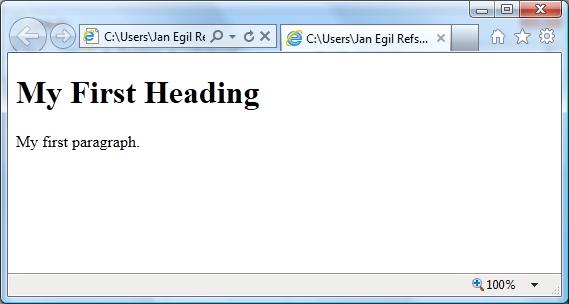HTML Introduction
HTML Example
<!DOCTYPE html>
<html>
<body>
<h1>My First Heading</h1>
<p>My first paragraph.</p>
</body>
</html>
<html>
<body>
<h1>My First Heading</h1>
<p>My first paragraph.</p>
</body>
</html>
Example Explained
- The DOCTYPE declaration defines the document type
- The text between <html> and </html> describes the web page
- The text between <body> and </body> is the visible page content
- The text between <h1> and </h1> is displayed as a heading
- The text between <p> and </p> is displayed as a paragraph
 |
The <!DOCTYPE html> declaration is the doctype for HTML5. |
|---|
What is HTML?
HTML is a language for describing web pages.- HTML stands for Hyper Text Markup Language
- HTML is a markup language
- A markup language is a set of markup tags
- The tags describe document content
- HTML documents contain HTML tags and plain text
- HTML documents are also called web pages
HTML Tags
HTML markup tags are usually called HTML tags.- HTML tags are keywords (tag names) surrounded by angle brackets like <html>
- HTML tags normally come in pairs like <p> and </p>
- The first tag in a pair is the start tag, the second tag is the end tag
- The end tag is written like the start tag, with a slash before the tag name
- Start and end tags are also called opening tags and closing tags
<tagname>content</tagname>
HTML Elements
In HTML, most elements are written with a start tag (e.g. <p>) and an end tag (e.g. </p>), with the content in between:
<p>This is a paragraph.</p>
Web Browsers
The purpose of a web browser (such as Google Chrome, Internet Explorer, Firefox, Safari) is to read HTML documents and display them as web pages.The browser does not display the HTML tags, but uses the tags to determine how the content of the HTML page is to be presented/displayed to the user:

HTML Page Structure
Below is a visualization of an HTML page structure:
<html>
<body>
</html>
<h1>This a heading</h1>
<p>This is a paragraph.</p>
<p>This is another paragraph.</p>
</body>
HTML Versions
Since the early days of the web, there have been many versions of HTML:| Version | Year |
|---|---|
| HTML | 1991 |
| HTML+ | 1993 |
| HTML 2.0 | 1995 |
| HTML 3.2 | 1997 |
| HTML 4.01 | 1999 |
| XHTML | 2000 |
| HTML5 | 2012 |
The <!DOCTYPE> Declaration
The <!DOCTYPE> declaration helps the browser to display a web page correctly.There are many different documents on the web, and a browser can only display an HTML page 100% correctly if it knows the HTML version and type used.
Common Declarations
HTML5
<!DOCTYPE html>
HTML 4.01
<!DOCTYPE HTML PUBLIC
"-//W3C//DTD HTML 4.01 Transitional//EN"
"http://www.w3.org/TR/html4/loose.dtd">
"http://www.w3.org/TR/html4/loose.dtd">
XHTML 1.0
<!DOCTYPE html PUBLIC "-//W3C//DTD XHTML 1.0 Transitional//EN"
"http://www.w3.org/TR/xhtml1/DTD/xhtml1-transitional.dtd">
"http://www.w3.org/TR/xhtml1/DTD/xhtml1-transitional.dtd">
for more www.w3schools.com visit
No comments:
Post a Comment